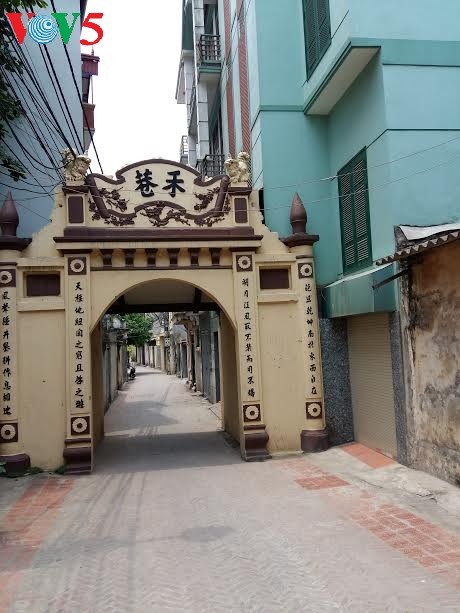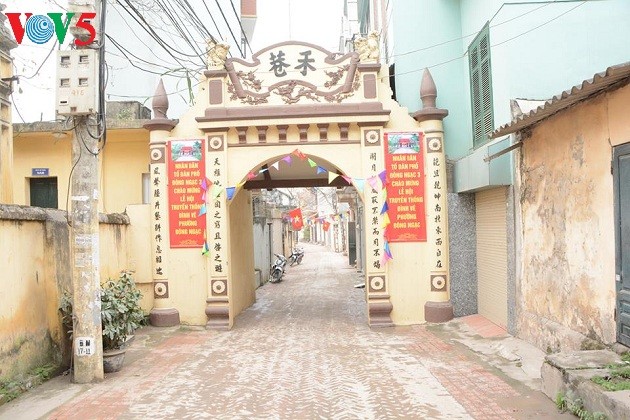(VOVWORLD) - Located 10 km from downtown Hanoi, by the Red River’s banks, Dong Ngac Village, formerly known as Ke Ve, is worth a visit to explore well-preserved traces of its past.
 A small gate leading to a hamlet of Dong Ngac Village. (Photo: Ngoc Anh) A small gate leading to a hamlet of Dong Ngac Village. (Photo: Ngoc Anh) |
The establishment of Dong Ngac Village is closely linked to the development of Thang Long Imperial Citadel.
For centuries, its ancient architectural features have been well-preserved. Each hamlet in Dong Ngac has a front gate directed towards the Red River and a rear gate looking towards the rice fields. The inner lanes still retain old names.

Hoa Lane, one of the most beautiful lanes in Dong Ngac Village. (Photo: Lan Anh)
|
The village elders said that in the past, when the local girls were married, they had to donate 300 bricks to pave the village road. After many years, the village roads were then all paved with bricks.
There remain many family worshipping and ancient houses in Dong Ngac. The village is well known for being home of many high-ranking mandarins during the feudal period in Vietnam. As such, the houses here were built sizably and delicately with pillars made of precious ironwood.
 The ancestral altar of the Do Clan, a well-known family in the village. (Photo: Ngoc Anh) The ancestral altar of the Do Clan, a well-known family in the village. (Photo: Ngoc Anh)
|
Do Quoc Hien, head of the Do clan in Dong Ngac Village, said the color of each pillar, horizontal lacquered boards, and parallel sentences have not faded.
Hien said: “In the past, Dong Ngac had 6 hamlets. Now it is divided into 4 residential groups. There are about 100 houses of a hundred years old. An ancient house of the Vietnamese people consists of 3 compartments and 2 lean-tos with the compartments at the center reserved for ancestral worshipping. The head of a clan is responsible of taking care of the house. The ancestral worshipping house’s gate is shaped like a book or a pen or decorated with parallel sentences as a way to remind the younger generation of studying hard to follow ancestors’ examples and uphold the clan’s tradition.”
Ancient houses in Dong Ngac combine traditional and French architecture styles. There are also villas built in the French style, which were previously for Western-educated intellectuals or successful merchants.
Dong Ngac Communal House is a national historical relic and one of the village’s most typical architectural works. Built in 1635, it worships three tutelary gods and honors more than 100 laureates.
The communal house displays 48 ancient paintings including eight engraved paintings praising popular professions in feudal times.
Elderly Pham Quang Dai said 7 steles recording the communal house’s construction and restoration process are kept there, adding “Dong Ngac Communal House embraces a typical architecture style. Looking down from the top, it looks like the head of a dragon. The three-door temple gate is the dragon’s nose and the two wells represent the dragon’s eyes. The main worshipping area is like the top of the dragon.”
Phan Trac Thuat, another village elderly, said: “The village has a time-honored culture with many temples and pagodas built from the Le Dynasty. The ancestral worshipping houses of clans have splendid architectural styles.”
To date, Dong Ngac villagers still preserve 45 royal documents conferred by Vietnamese Kings from the Le dynasty to the Nguyen dynasty.